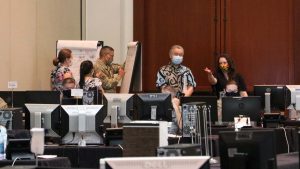Ramping up Hawaii’s corps of ‘disease detectives”
Posted on Aug 27, 2020 in Capitol Connection, Featured
Governor Ige and Department of Health branch chief Dr. Emily Roberson in the expanded space for contact tracers at the Hawai‘i Convention Center.
Fighting the pandemic is taking a new turn in Hawai‘i with a newly hired director of Disease Investigation, an expanded corps of investigators and contact tracers and a bigger workspace at the Hawai‘i Convention Center. Dr. Emily Roberson, the Department of Health’s new branch chief, joined Governor Ige, HI-EMA director Kenneth Hara and DOH director Dr. Bruce Anderson at a news conference last month to describe expansion of the state’s contact tracing system, including the addition of Hawai‘i National Guard personnel and those recently trained by the University of Hawai‘i.
“I know many are concerned about the number of cases in our state, and we are too,” said Dr. Roberson. “That’s why our team is accelerating and expanding our disease investigation program.” The streamlining was designed for better workload distribution, simplified data collection, and focus on four groups to prevent larger-scale outbreaks. These groups include those in high-risk occupations, such as health care workers; high-risk settings, such as long-term care facilities, correctional facilities and public housing; high-risk individuals (older than 65 and those with chronic health conditions); and those sick with symptoms.

Governor Ige, Chief of Staff Linda Takayama with National Guard contact tracers. At far left, DOH branch chief Dr. Emily Roberson and HI-EMA director Kenneth Hara.
“Our goal is to focus our efforts to reduce the odds of spreading the disease further in our community,” said Dr. Roberson. She went on to explain the system developed to bring down case numbers. “It’s not something that happens in a vacuum. Contact tracers function as part of a team. We’re in the process of scaling up to be responsive to the numbers and the situation here on the ground.” Roberson said there are currently 126 contact tracers statewide and 13 support staff, with plans to add more. Director Hara added, “(The National Guard) anticipated needs and were able to train ahead of time. So when the request came, we were ready.”